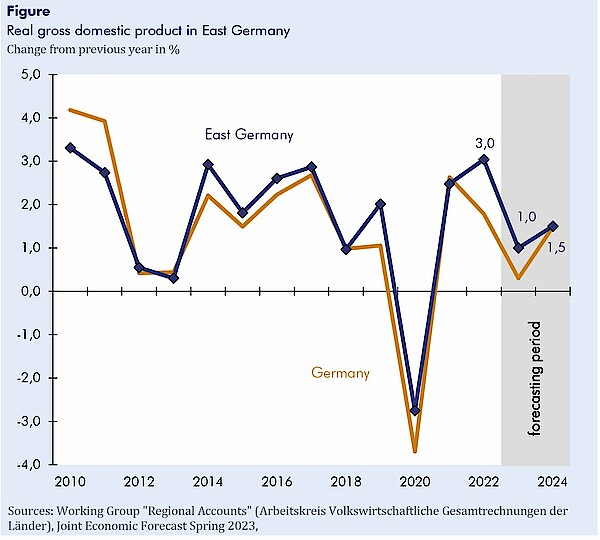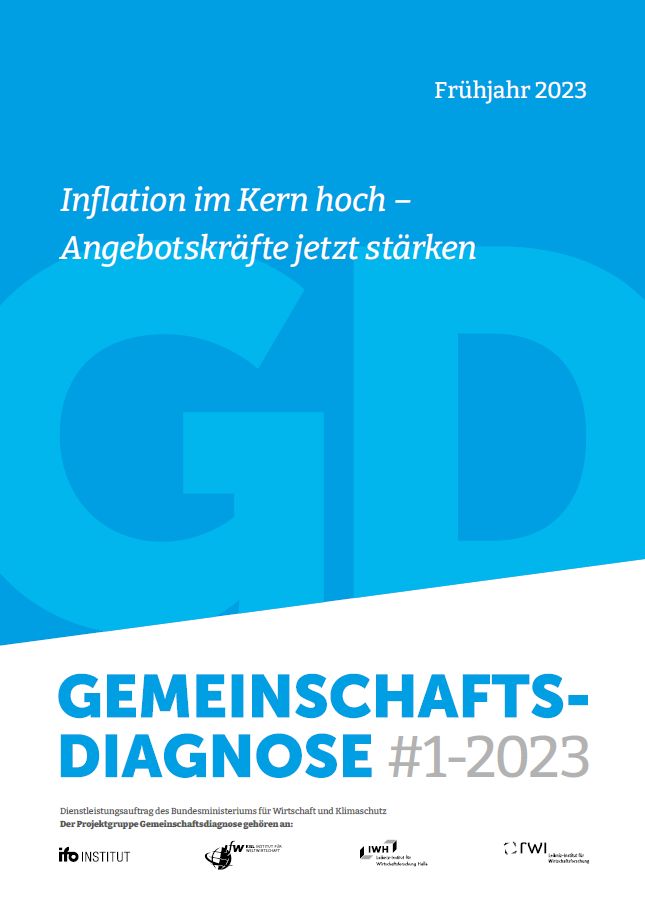East German economy has come through energy crisis well so far – Implications of the Joint Economic Forecast Spring 2023 and new data for the East German economy
In its spring report, the Joint Economic Forecast states that the economic setback for the German economy in winter 2022/2023 is likely to have been less severe than feared in autumn. This is because the supply-side disruptions, especially the danger of an acute supply shortage of natural gas, have eased. Overall, the East German economy has come through last year's energy crisis quite well: According to recent official data, economic output expanded by 3.0%, 1.5 percentage points more than in West Germany (1.5%). Value added in the East German manufacturing sector increased by 1.5%, with very high growth of 13.4% in Brandenburg, that is probably mainly due to the start of car production at the Tesla plant in Grünheide. In East Germany excluding Brandenburg, manufacturing merely stagnated, as in Germany as a whole. Construction output declined by 3.5% in the east, somewhat more than in the rest of the country. In contrast, value added in the important service sector of trade, transport, hotels and restaurants, information and communication (economic sectors G to J) increased by 4.4% in the east excluding Berlin and by 9.2% in the German capital, much more than in West Germany (3.5%). “The background, apart from catch-up effects after the end of the pandemic, is likely to be a robust development of households’ disposable income,” says Oliver Holtemöller, Head of the Department Macroeconomics and Vice President at the Halle Institute for Economic Research (IWH). Since the minimum wage was raised to 12 euros per hour in October 2022, it is up by more than a quarter relative to 2021. This is more significant for East Germany than for the west because of the higher proportion of minimum wage recipients, and it is one reason why East German gross wages and salaries per employee have risen more significantly (6.4%) than in Germany as a whole (4.7%). In East Germany, real (consumer price adjusted) gross wages and salaries per employee were 12½% higher in 2022 than in 2015, but they were only about 4% higher in Germany as a whole. Despite the higher wage costs and a less favourable demographic development, employment is expanding significantly in the east as well as in the west.

“In 2023, incomes in East Germany are also likely to expand more strongly than in the west,” Holtemöller says. “This is because in the summer, the statutory pension will increase by 5.9% and thus by 1.5 percentage points more than in the West.” The alignment of the pension value between east and west will then be achieved, and in the future, pension adjustments will be uniform throughout the country. For the first half of 2023, the Joint Economic Forecast sees a modest increase in German GDP; in the following quarters, growth is likely to be somewhat higher due to easing supply bottlenecks and lighter burdens from energy prices. This should also apply to East Germany. Due to the stronger development of private incomes (though at a lower level), East German output is likely to expand at a slightly higher rate of 1.0% in 2023 than in Germany as a whole (0.3%, see figure). For 2024, the expansion rates will probably converge (1.5%). The East German unemployment rate as defined by the Federal Employment Agency will remain roughly constant at 6.8% in 2023 and 6.7% in 2024, after 6.7% in 2022.
Joint Economic Forecast, Spring 2023 Report (in German):
Joint Economic Forecast: Inflation im Kern hoch – Angebotskräfte jetzt stärken. München, April 2023.
Whom to contact
For Researchers

Vice President Department Head
If you have any further questions please contact me.
+49 345 7753-800 Request per E-MailFor Journalists

Internal and External Communications
If you have any further questions please contact me.
+49 345 7753-832 Request per E-MailIWH list of experts
The IWH list of experts provides an overview of IWH research topics and the researchers and scientists in these areas. The relevant experts for the topics listed there can be reached for questions as usual through the IWH Press Office.
Related Publications

Gemeinschaftsdiagnose: Inflation im Kern hoch – Angebotskräfte jetzt stärken
in: Dienstleistungsauftrag des Bundesministeriums für Wirtschaft und Klimaschutz, 1, 2023
Abstract
<p>Der konjunkturelle Rückschlag im Winterhalbjahr 2022/2023 dürfte glimpflicher ausgefallen sein als im Herbst befürchtet. Die angebotsseitigen Störungen, die die deutsche Wirtschaft seit geraumer Zeit belasten, haben nachgelassen. Ein merklicher Rückgang der Inflationsraten wird jedoch noch etwas auf sich warten lassen, da der Nachfragesog vorerst kaum geringer werden dürfte. Dazu tragen neben den staatlichen Entlastungsmaßnahmen auch die absehbar hohen Lohnsteigerungen bei. Die Inflationsrate wird im Jahr 2023 mit 6,0% nur wenig niedriger liegen als im Vorjahr. Erst im kommenden Jahr dürfte die Rate, insbesondere aufgrund der rückläufigen Energiepreise, spürbar sinken. Der Rückgang der Kerninflationsrate (also der Anstieg der Verbraucherpreise ohne Energie) fällt zunächst deutlich schwächer aus. Sie dürfte von 6,2% im laufenden Jahr nur langsam auf 3,3% im kommenden Jahr zurückgehen. <br /><br />Das Verarbeitende Gewerbe wird in den kommenden Quartalen zur Konjunkturstütze werden, da es unmittelbar vom Abflauen der Lieferengpässe und der wieder etwas günstigeren Energie profitiert. Da die Reallöhne wieder anziehen, wird auch der private Konsum im weiteren Verlauf zur gesamtwirtschaftlichen Expansion beitragen. Die Bauwirtschaft wird die Konjunktur hingegen bremsen, da die Nachfrage auch als Folge der gestiegenen Finanzierungskosten schwach bleiben wird. Das preisbereinigte Bruttoinlandsprodukt wird in diesem Jahr um 0,3% und im kommenden Jahr um 1,5% zulegen. Damit heben die Institute ihre Prognose vom Herbst 2022 für das laufende Jahr spürbar um 0,7 Prozentpunkte an, während die Prognose für das kommende Jahr um 0,4 Prozentpunkte gesenkt wird. Die Wirtschaftspolitik hat in den vergangenen Jahren die angebotspolitischen Zügel weitgehend schleifen lassen, auch in Zeiten, in denen kein akutes Krisenmanagement anstand. Umso größer ist nun der Reformbedarf, um insbesondere die Herausforderungen des demografischen Wandels und der Energiewende zu bewältigen. Beide erfordern potenzialstärkende Maßnahmen, auch um die sich verschärfenden Verteilungskonflikte einzuhegen. </p>



